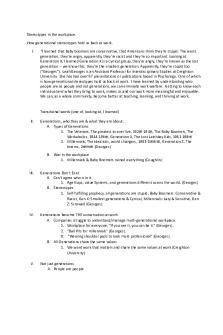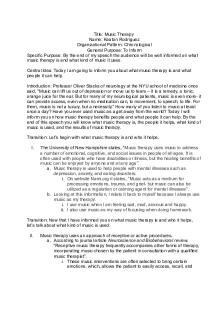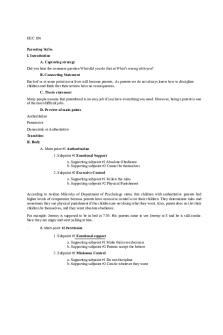Informative Speech on The Evolution of Cameras PDF

| Title | Informative Speech on The Evolution of Cameras |
|---|---|
| Course | Introduction to Speech |
| Institution | Lincoln Land Community College |
| Pages | 4 |
| File Size | 86.1 KB |
| File Type | |
| Total Downloads | 46 |
| Total Views | 140 |
Summary
Cameras...
Description
Ben Brower 03/23/2021 Ms. Pettit Informative Speech Draft
Introduction A. Attention Getter- Imagine if we didn’t have cameras. We wouldn’t be able to capture life's greatest moments. We wouldn’t have movies or television or even security. B. This is important because it shows the history of our cameras and how they came to be and how they evolved over the years. C. I have always been interested in cameras whether it was from how they worked to how they are made cameras have and always will be a big part of my life. Thesis
A. Cameras have been around for many years, they are constantly changing and finding new ways to better improve them. But when and how did the idea come to be? Main Points
A. What is a camera? B. First camera C. Cameras Evolution
A. First, I will talk about what a camera is. B. Second, I will talk about the first camera. C. Finally, I will talk about the evolution of the camera. First Main Point- What is a Camera?
A. A camera is a device that is used to take photographs. There are five main components to a camera. There’s the camera box which holds and protects the sensitive film from all light except light that enters through the lens. Next there’s the film, a light-sensitive strip that is wound on a spool in which the image will be recorded on as pictures are taken. Next there’s the light control which consisted of an aperture that controls how much or how little light is let in. Next is the lens which focuses light rays from the subject onto
film creating the image. The lens also controls the focus of the camera making the image clearer and sharper. Last is the viewfinder which is a small opening in the top of the camera in which the eye is pressed against in order to view the frame.
Second Main Point- The First Camera.
A. The first camera was invented by Joseph Nicephore Niepce. The camera was called a “Camera Obscura”. Obscura being the Latin meaning for “Dark Chamber”. In which the camera obscura had a series of darkened room boxes each had a small hole in the center to allow light through. The camera obscura was also used to view solar eclipses by taking the image from the obscura and inverting it on the opposite wall so that people could watch the eclipse without endangering the eyes. In 1839 an inventor by the name of Louis-Jacques-Mandé Daguerre who invented the Daguerreotype which was a camera that was meant for portraits and around the early 40’s portraits became extremely popular and the camera obscura could not compete. B. Which brings me to my third point the evolution of cameras.
Third Main Point- The Evolution of The Camera. With the camera obscura not able to compete the new and popular camera at the time was the Daguerreotype which was a box camera that was very heavy in weight. This camera took a lot of famous pictures and people’s portraits such as the first daguerreotype of the moon in 1839 by John William Draper. That was taken from a rooftop in New York. Another famous photo that was taken from the Daguerreotype was a portrait of America’s 16th president Abraham Lincoln. Taken when Lincoln was 37 a lawyer and congressmen-elect and was living in Springfield, Illinois. This camera was very popular up until the late 1800’s. Although this camera took much sharper and clear images the camera itself had a hard time controlling light exposure therefore images were often dark and the person getting their picture taken had to stand or sit still for up to several minutes to get the exposure correct. This along with the camera being so expensive made this camera lose its popularity. So, in 1888 George Eastman invented a camera that was much more compact and affordable he called it the Kodak. The Kodak was revolutionary for the camera industry. The Kodak had and could do things that no other camera could or had at that time and that was film. The Kodak came preloaded with a 100-exposure roll of flexible film. This meant that people could expose multiple images at once instead of exposing images 1 by 1. Which people liked but what mainly made this camera popular is that when the roll of flexible film was finished you could just mail the camera back to the company for where they would print the pictures for $10 and then they would replace the film with a fresh roll for $2 and then the company would mail the camera back to the owner. Where they could then take more pictures. The Kodak was very popular but in 1948 Edwin Land invented the Polaroid camera. The polaroid camera became popular because when you took a picture with the polaroid the picture would print out shortly after the picture was taken. People liked the polaroid camera
because unlike the Kodak the picture would print right out for you instead of paying to mail your camera and have them printed at the company. The polaroid camera is packed inside a leather carrying case. When ready to be used the person would just pull out and downward to release the camera's lens. The polaroid was a great camera and all but in 1975 the first Digital camera was invented by Steven Sasson who was an engineer at Kodak. The Digital camera weighed 8 pounds and shot a 0.01 Megapixel. The camera took 50 milliseconds to capture an image and after being captured the image would then be digitized and would be stored in the digital memory card. This method captured the image but didn’t permanently store the image. The only option at the time was digital cassette which took about 23 seconds to record the 100 pixel by 100 pixel black and white image. The digital cassette could hold up to 30 images then it would have to be replaced. Conclusion In conclusion I have talked about what a camera is and does. I also talked about the invention of the first camera. And lastly i talked about the evolution of the camera. I leave you with a quote from Steven Sasson. "I thought it represented a bit of a view into the future, but what we can do with images today is amazing,"- Steven Sasson 2005 Work Cited Devlin, Ann. “History of Cameras: Illustrated Timeline.” Photodoto, 2006, photodoto.com/camera-history-timeline/. Finch, Garry. “A Brief History Of The Camera.” Photography Basics, Photography Basics, 12 Sep. 2014, www.photography-basics.com/history-of-the-camera/. Bells, Mary. “A Comprehensive Look at the History of Photography.” Thought Co, November 6, 2017, https://www.thoughtco.com/history-of-photography-and-the-camera-1992331.
“Camera.” Encyclopædia Britannica, Encyclopædia Britannica, Inc., www.britannica.com/technology/camera. “History of the Cameras - Timeline.” ScanCorner, 6 July 2015, www.scancorner.com.au/historyof-the-cameras-timeline/. http://www.loc.gov/teachers/classroommaterials/connections/daguerreotype/history.html
“8 Important Daguerreotype Photos.” Mental Floss, 19 Aug. 2013, mentalfloss.com/article/52299/8-important-daguerreotype-photos. “Original Kodak Camera, Serial No. 540.” National Museum of American History, americanhistory.si.edu/collections/search/object/nmah_760118.
“George Eastman.” Biography.com, A&E Networks Television, 22 June 2020, www.biography.com/people/george-eastman-9283428....
Similar Free PDFs

Informative speech
- 4 Pages

Informative Speech
- 3 Pages

Informative speech
- 3 Pages

Informative Speech
- 3 Pages

Informative Speech
- 3 Pages

INFORMATIVE SPEECH
- 6 Pages

Informative Speech
- 3 Pages

Informative Speech
- 8 Pages

Informative Speech
- 5 Pages
Popular Institutions
- Tinajero National High School - Annex
- Politeknik Caltex Riau
- Yokohama City University
- SGT University
- University of Al-Qadisiyah
- Divine Word College of Vigan
- Techniek College Rotterdam
- Universidade de Santiago
- Universiti Teknologi MARA Cawangan Johor Kampus Pasir Gudang
- Poltekkes Kemenkes Yogyakarta
- Baguio City National High School
- Colegio san marcos
- preparatoria uno
- Centro de Bachillerato Tecnológico Industrial y de Servicios No. 107
- Dalian Maritime University
- Quang Trung Secondary School
- Colegio Tecnológico en Informática
- Corporación Regional de Educación Superior
- Grupo CEDVA
- Dar Al Uloom University
- Centro de Estudios Preuniversitarios de la Universidad Nacional de Ingeniería
- 上智大学
- Aakash International School, Nuna Majara
- San Felipe Neri Catholic School
- Kang Chiao International School - New Taipei City
- Misamis Occidental National High School
- Institución Educativa Escuela Normal Juan Ladrilleros
- Kolehiyo ng Pantukan
- Batanes State College
- Instituto Continental
- Sekolah Menengah Kejuruan Kesehatan Kaltara (Tarakan)
- Colegio de La Inmaculada Concepcion - Cebu






